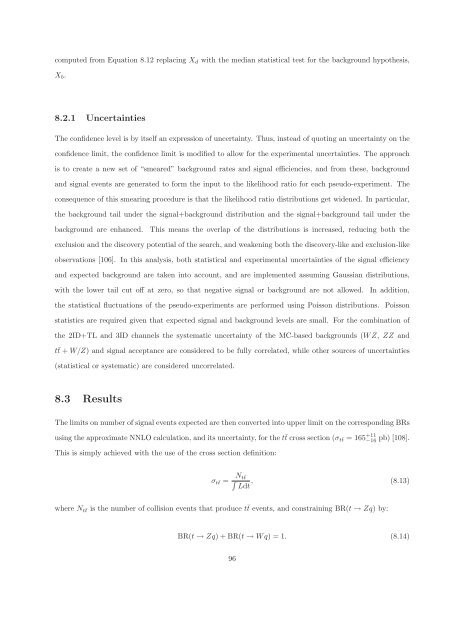CERN-THESIS-2012-153 26/07/2012 - CERN Document Server
CERN-THESIS-2012-153 26/07/2012 - CERN Document Server
CERN-THESIS-2012-153 26/07/2012 - CERN Document Server
You also want an ePaper? Increase the reach of your titles
YUMPU automatically turns print PDFs into web optimized ePapers that Google loves.
computed from Equation 8.12 replacing Xd with the median statistical test for the background hypothesis,<br />
Xb.<br />
8.2.1 Uncertainties<br />
The confidence level is by itself an expression of uncertainty. Thus, instead of quoting an uncertainty on the<br />
confidence limit, the confidence limit is modified to allow for the experimental uncertainties. The approach<br />
is to create a new set of “smeared” background rates and signal efficiencies, and from these, background<br />
and signal events are generated to form the input to the likelihood ratio for each pseudo-experiment. The<br />
consequence of this smearing procedure is that the likelihood ratio distributions get widened. In particular,<br />
the background tail under the signal+background distribution and the signal+background tail under the<br />
background are enhanced. This means the overlap of the distributions is increased, reducing both the<br />
exclusion and the discovery potential of the search, and weakening both the discovery-like and exclusion-like<br />
observations [106]. In this analysis, both statistical and experimental uncertainties of the signal efficiency<br />
and expected background are taken into account, and are implemented assuming Gaussian distributions,<br />
with the lower tail cut off at zero, so that negative signal or background are not allowed. In addition,<br />
the statistical fluctuations of the pseudo-experiments are performed using Poisson distributions. Poisson<br />
statistics are required given that expected signal and background levels are small. For the combination of<br />
the 2ID+TL and 3ID channels the systematic uncertainty of the MC-based backgrounds (WZ, ZZ and<br />
t¯t + W/Z) and signal acceptance are considered to be fully correlated, while other sources of uncertainties<br />
(statistical or systematic) are considered uncorrelated.<br />
8.3 Results<br />
The limits on number of signal events expected are then converted into upper limit on the corresponding BRs<br />
using the approximate NNLO calculation, and its uncertainty, for the t¯t cross section (σt¯t = 165 +11<br />
−16 pb) [108].<br />
This is simply achieved with the use of the cross section definition:<br />
σt¯t = Nt¯t , (8.13)<br />
Ldt<br />
where N t¯t is the number of collision events that produce t¯t events, and constraining BR(t → Zq) by:<br />
BR(t → Zq) + BR(t → Wq) = 1. (8.14)<br />
96















